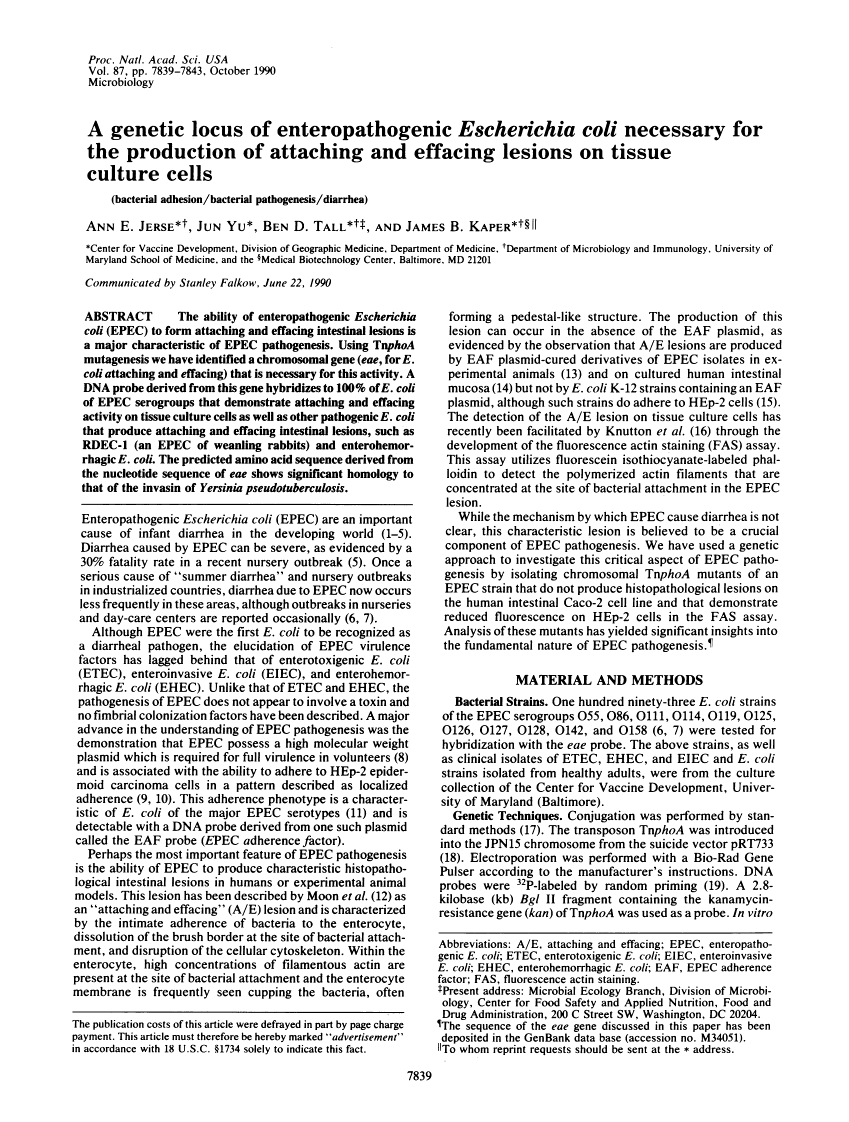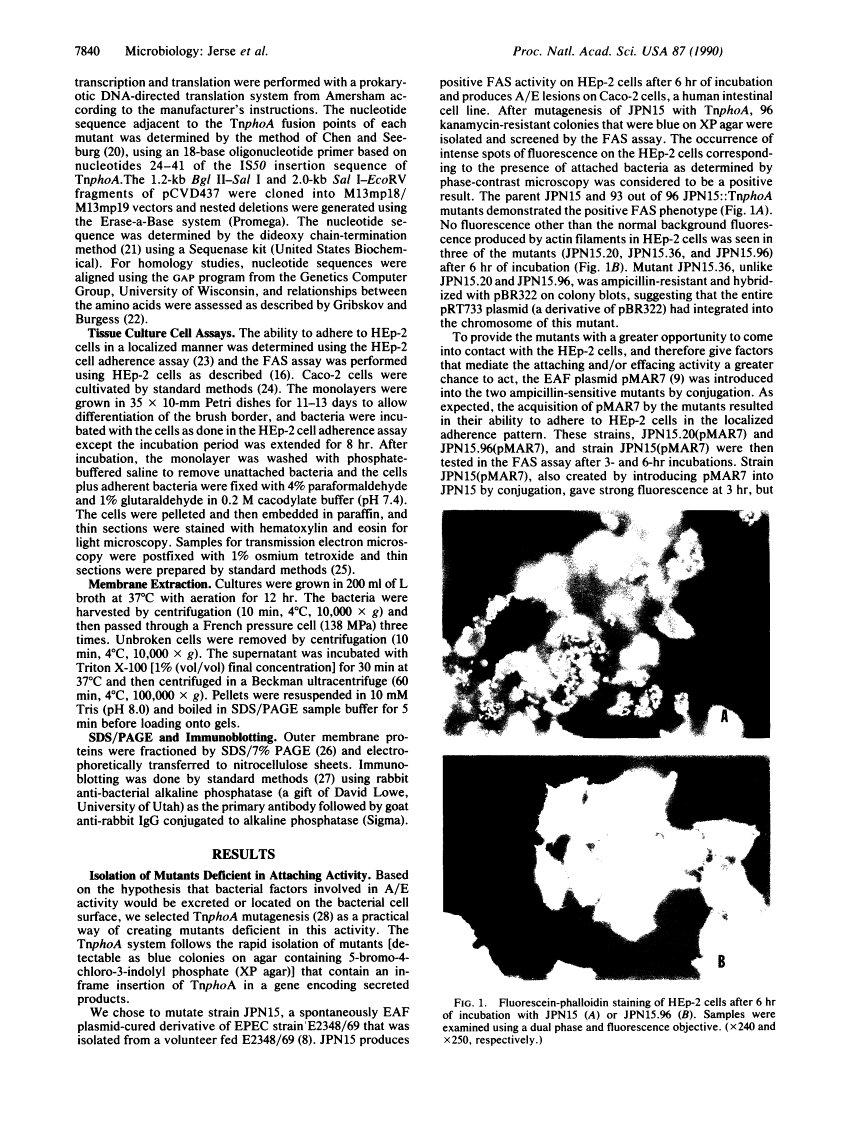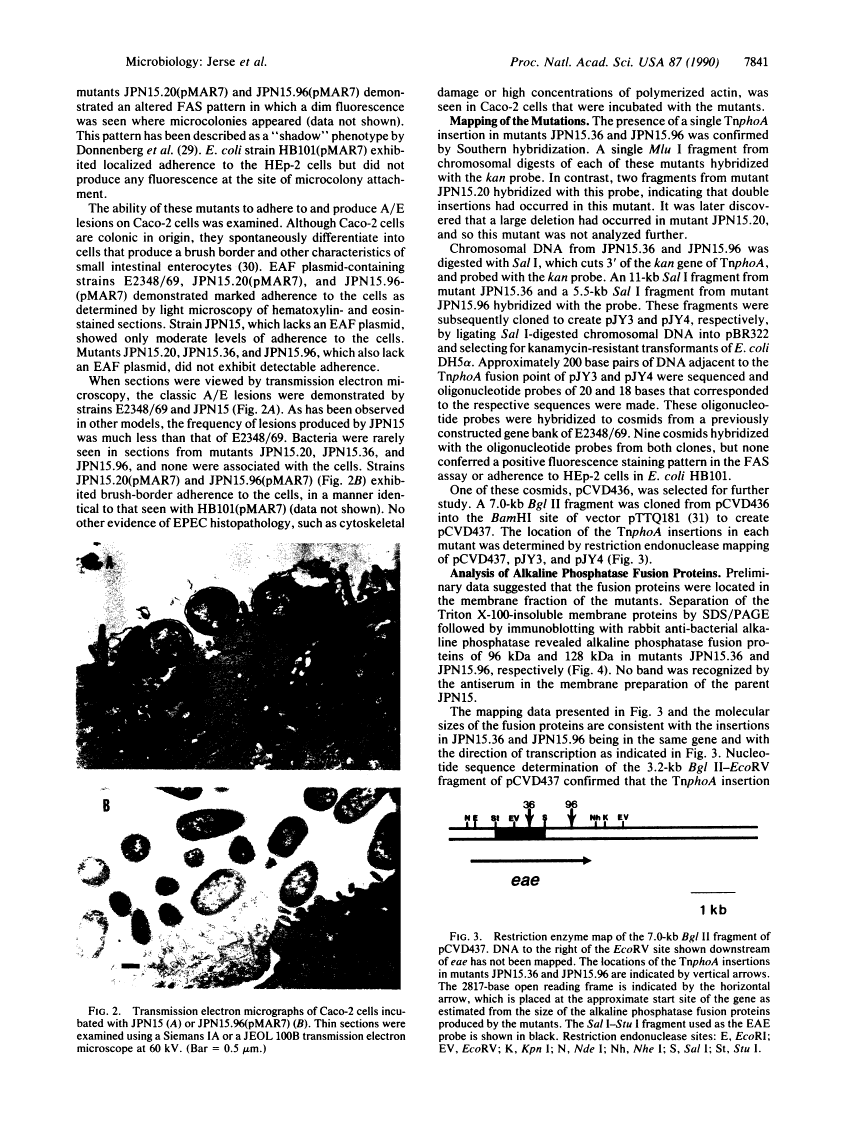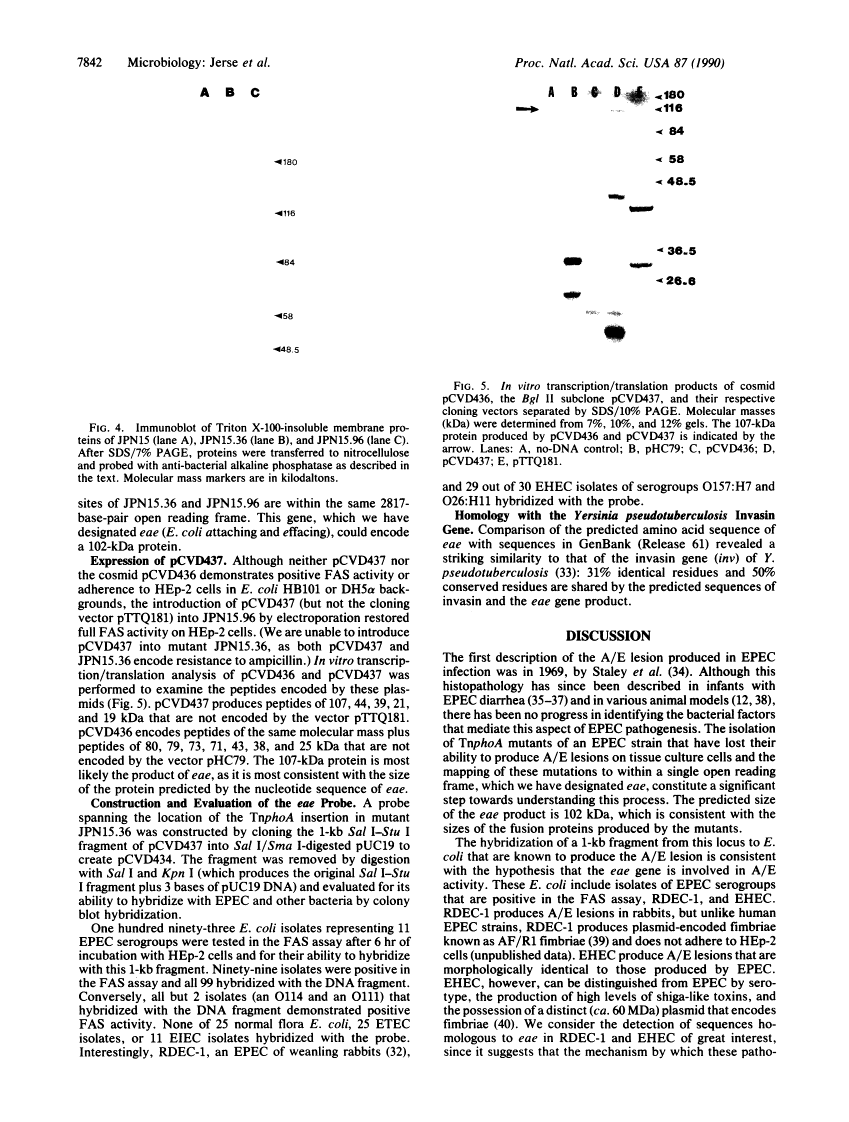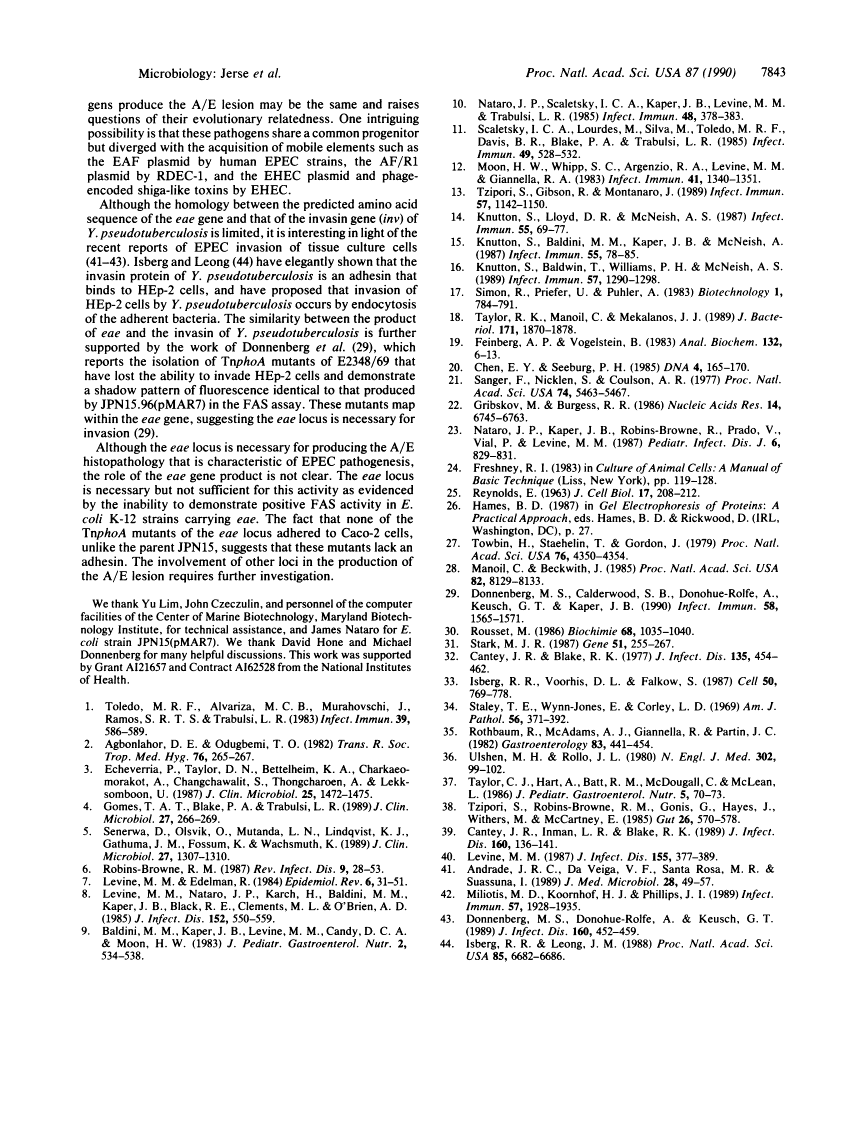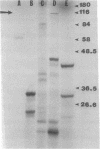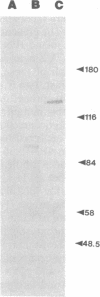Abstract
Free full text

A genetic locus of enteropathogenic Escherichia coli necessary for the production of attaching and effacing lesions on tissue culture cells.
Abstract
The ability of enteropathogenic Escherichia coli (EPEC) to form attaching and effacing intestinal lesions is a major characteristic of EPEC pathogenesis. Using TnphoA mutagenesis we have identified a chromosomal gene (eae, for E. coli attaching and effacing) that is necessary for this activity. A DNA probe derived from this gene hybridizes to 100% of E. coli of EPEC serogroups that demonstrate attaching and effacing activity on tissue culture cells as well as other pathogenic E. coli that produce attaching and effacing intestinal lesions, such as RDEC-1 (an EPEC of weanling rabbits) and enterohemorrhagic E. coli. The predicted amino acid sequence derived from the nucleotide sequence of eae shows significant homology to that of the invasin of Yersinia pseudotuberculosis.
Full text
Full text is available as a scanned copy of the original print version. Get a printable copy (PDF file) of the complete article (1.6M), or click on a page image below to browse page by page. Links to PubMed are also available for Selected References.
Images in this article
Click on the image to see a larger version.
Selected References
These references are in PubMed. This may not be the complete list of references from this article.
- Toledo MR, Alvariza M do C, Murahovschi J, Ramos SR, Trabulsi LR. Enteropathogenic Escherichia coli serotypes and endemic diarrhea in infants. Infect Immun. 1983 Feb;39(2):586–589. [Europe PMC free article] [Abstract] [Google Scholar]
- Agbonlahor DE, Odugbemi TO. Enteropathogenic, enterotoxigenic and enteroinvasive Escherichia coli isolated from acute gastroenteritis patients in Lagos, Nigeria. Trans R Soc Trop Med Hyg. 1982;76(2):265–267. [Abstract] [Google Scholar]
- Echeverria P, Taylor DN, Bettelheim KA, Chatkaeomorakot A, Changchawalit S, Thongcharoen A, Leksomboon U. HeLa cell-adherent enteropathogenic Escherichia coli in children under 1 year of age in Thailand. J Clin Microbiol. 1987 Aug;25(8):1472–1475. [Europe PMC free article] [Abstract] [Google Scholar]
- Gomes TA, Blake PA, Trabulsi LR. Prevalence of Escherichia coli strains with localized, diffuse, and aggregative adherence to HeLa cells in infants with diarrhea and matched controls. J Clin Microbiol. 1989 Feb;27(2):266–269. [Europe PMC free article] [Abstract] [Google Scholar]
- Senerwa D, Olsvik O, Mutanda LN, Lindqvist KJ, Gathuma JM, Fossum K, Wachsmuth K. Enteropathogenic Escherichia coli serotype O111:HNT isolated from preterm neonates in Nairobi, Kenya. J Clin Microbiol. 1989 Jun;27(6):1307–1311. [Europe PMC free article] [Abstract] [Google Scholar]
- Robins-Browne RM. Traditional enteropathogenic Escherichia coli of infantile diarrhea. Rev Infect Dis. 1987 Jan-Feb;9(1):28–53. [Abstract] [Google Scholar]
- Levine MM, Edelman R. Enteropathogenic Escherichia coli of classic serotypes associated with infant diarrhea: epidemiology and pathogenesis. Epidemiol Rev. 1984;6:31–51. [Abstract] [Google Scholar]
- Levine MM, Nataro JP, Karch H, Baldini MM, Kaper JB, Black RE, Clements ML, O'Brien AD. The diarrheal response of humans to some classic serotypes of enteropathogenic Escherichia coli is dependent on a plasmid encoding an enteroadhesiveness factor. J Infect Dis. 1985 Sep;152(3):550–559. [Abstract] [Google Scholar]
- Baldini MM, Kaper JB, Levine MM, Candy DC, Moon HW. Plasmid-mediated adhesion in enteropathogenic Escherichia coli. J Pediatr Gastroenterol Nutr. 1983;2(3):534–538. [Abstract] [Google Scholar]
- Nataro JP, Scaletsky IC, Kaper JB, Levine MM, Trabulsi LR. Plasmid-mediated factors conferring diffuse and localized adherence of enteropathogenic Escherichia coli. Infect Immun. 1985 May;48(2):378–383. [Europe PMC free article] [Abstract] [Google Scholar]
- Scaletsky IC, Silva ML, Toledo MR, Davis BR, Blake PA, Trabulsi LR. Correlation between adherence to HeLa cells and serogroups, serotypes, and bioserotypes of Escherichia coli. Infect Immun. 1985 Sep;49(3):528–532. [Europe PMC free article] [Abstract] [Google Scholar]
- Moon HW, Whipp SC, Argenzio RA, Levine MM, Giannella RA. Attaching and effacing activities of rabbit and human enteropathogenic Escherichia coli in pig and rabbit intestines. Infect Immun. 1983 Sep;41(3):1340–1351. [Europe PMC free article] [Abstract] [Google Scholar]
- Tzipori S, Gibson R, Montanaro J. Nature and distribution of mucosal lesions associated with enteropathogenic and enterohemorrhagic Escherichia coli in piglets and the role of plasmid-mediated factors. Infect Immun. 1989 Apr;57(4):1142–1150. [Europe PMC free article] [Abstract] [Google Scholar]
- Knutton S, Lloyd DR, McNeish AS. Adhesion of enteropathogenic Escherichia coli to human intestinal enterocytes and cultured human intestinal mucosa. Infect Immun. 1987 Jan;55(1):69–77. [Europe PMC free article] [Abstract] [Google Scholar]
- Knutton S, Baldini MM, Kaper JB, McNeish AS. Role of plasmid-encoded adherence factors in adhesion of enteropathogenic Escherichia coli to HEp-2 cells. Infect Immun. 1987 Jan;55(1):78–85. [Europe PMC free article] [Abstract] [Google Scholar]
- Knutton S, Baldwin T, Williams PH, McNeish AS. Actin accumulation at sites of bacterial adhesion to tissue culture cells: basis of a new diagnostic test for enteropathogenic and enterohemorrhagic Escherichia coli. Infect Immun. 1989 Apr;57(4):1290–1298. [Europe PMC free article] [Abstract] [Google Scholar]
- Taylor RK, Manoil C, Mekalanos JJ. Broad-host-range vectors for delivery of TnphoA: use in genetic analysis of secreted virulence determinants of Vibrio cholerae. J Bacteriol. 1989 Apr;171(4):1870–1878. [Europe PMC free article] [Abstract] [Google Scholar]
- Feinberg AP, Vogelstein B. A technique for radiolabeling DNA restriction endonuclease fragments to high specific activity. Anal Biochem. 1983 Jul 1;132(1):6–13. [Abstract] [Google Scholar]
- Chen EY, Seeburg PH. Supercoil sequencing: a fast and simple method for sequencing plasmid DNA. DNA. 1985 Apr;4(2):165–170. [Abstract] [Google Scholar]
- Sanger F, Nicklen S, Coulson AR. DNA sequencing with chain-terminating inhibitors. Proc Natl Acad Sci U S A. 1977 Dec;74(12):5463–5467. [Europe PMC free article] [Abstract] [Google Scholar]
- Gribskov M, Burgess RR. Sigma factors from E. coli, B. subtilis, phage SP01, and phage T4 are homologous proteins. Nucleic Acids Res. 1986 Aug 26;14(16):6745–6763. [Europe PMC free article] [Abstract] [Google Scholar]
- Nataro JP, Kaper JB, Robins-Browne R, Prado V, Vial P, Levine MM. Patterns of adherence of diarrheagenic Escherichia coli to HEp-2 cells. Pediatr Infect Dis J. 1987 Sep;6(9):829–831. [Abstract] [Google Scholar]
- REYNOLDS ES. The use of lead citrate at high pH as an electron-opaque stain in electron microscopy. J Cell Biol. 1963 Apr;17:208–212. [Europe PMC free article] [Abstract] [Google Scholar]
- Towbin H, Staehelin T, Gordon J. Electrophoretic transfer of proteins from polyacrylamide gels to nitrocellulose sheets: procedure and some applications. Proc Natl Acad Sci U S A. 1979 Sep;76(9):4350–4354. [Europe PMC free article] [Abstract] [Google Scholar]
- Manoil C, Beckwith J. TnphoA: a transposon probe for protein export signals. Proc Natl Acad Sci U S A. 1985 Dec;82(23):8129–8133. [Europe PMC free article] [Abstract] [Google Scholar]
- Donnenberg MS, Calderwood SB, Donohue-Rolfe A, Keusch GT, Kaper JB. Construction and analysis of TnphoA mutants of enteropathogenic Escherichia coli unable to invade HEp-2 cells. Infect Immun. 1990 Jun;58(6):1565–1571. [Europe PMC free article] [Abstract] [Google Scholar]
- Rousset M. The human colon carcinoma cell lines HT-29 and Caco-2: two in vitro models for the study of intestinal differentiation. Biochimie. 1986 Sep;68(9):1035–1040. [Abstract] [Google Scholar]
- Stark MJ. Multicopy expression vectors carrying the lac repressor gene for regulated high-level expression of genes in Escherichia coli. Gene. 1987;51(2-3):255–267. [Abstract] [Google Scholar]
- Cantey JR, Blake RK. Diarrhea due to Escherichia coli in the rabbit: a novel mechanism. J Infect Dis. 1977 Mar;135(3):454–462. [Abstract] [Google Scholar]
- Isberg RR, Voorhis DL, Falkow S. Identification of invasin: a protein that allows enteric bacteria to penetrate cultured mammalian cells. Cell. 1987 Aug 28;50(5):769–778. [Abstract] [Google Scholar]
- Staley TE, Jones EW, Corley LD. Attachment and penetration of Escherichia coli into intestinal epithelium of the ileum in newborn pigs. Am J Pathol. 1969 Sep;56(3):371–392. [Europe PMC free article] [Abstract] [Google Scholar]
- Rothbaum R, McAdams AJ, Giannella R, Partin JC. A clinicopathologic study of enterocyte-adherent Escherichia coli: a cause of protracted diarrhea in infants. Gastroenterology. 1982 Aug;83(2):441–454. [Abstract] [Google Scholar]
- Ulshen MH, Rollo JL. Pathogenesis of escherichia coli gastroenteritis in man--another mechanism. N Engl J Med. 1980 Jan 10;302(2):99–101. [Abstract] [Google Scholar]
- Taylor CJ, Hart A, Batt RM, McDougall C, McLean L. Ultrastructural and biochemical changes in human jejunal mucosa associated with enteropathogenic Escherichia coli (0111) infection. J Pediatr Gastroenterol Nutr. 1986 Jan;5(1):70–73. [Abstract] [Google Scholar]
- Tzipori S, Robins-Browne RM, Gonis G, Hayes J, Withers M, McCartney E. Enteropathogenic Escherichia coli enteritis: evaluation of the gnotobiotic piglet as a model of human infection. Gut. 1985 Jun;26(6):570–578. [Europe PMC free article] [Abstract] [Google Scholar]
- Cantey JR, Inman LR, Blake RK. Production of diarrhea in the rabbit by a mutant of Escherichia coli (RDEC-1) that does not express adherence (AF/R1) pili. J Infect Dis. 1989 Jul;160(1):136–141. [Abstract] [Google Scholar]
- Levine MM. Escherichia coli that cause diarrhea: enterotoxigenic, enteropathogenic, enteroinvasive, enterohemorrhagic, and enteroadherent. J Infect Dis. 1987 Mar;155(3):377–389. [Abstract] [Google Scholar]
- Andrade JR, Da Veiga VF, De Santa Rosa MR, Suassuna I. An endocytic process in HEp-2 cells induced by enteropathogenic Escherichia coli. J Med Microbiol. 1989 Jan;28(1):49–57. [Abstract] [Google Scholar]
- Miliotis MD, Koornhof HJ, Phillips JI. Invasive potential of noncytotoxic enteropathogenic Escherichia coli in an in vitro Henle 407 cell model. Infect Immun. 1989 Jul;57(7):1928–1935. [Europe PMC free article] [Abstract] [Google Scholar]
- Donnenberg MS, Donohue-Rolfe A, Keusch GT. Epithelial cell invasion: an overlooked property of enteropathogenic Escherichia coli (EPEC) associated with the EPEC adherence factor. J Infect Dis. 1989 Sep;160(3):452–459. [Abstract] [Google Scholar]
- Isberg RR, Leong JM. Cultured mammalian cells attach to the invasin protein of Yersinia pseudotuberculosis. Proc Natl Acad Sci U S A. 1988 Sep;85(18):6682–6686. [Europe PMC free article] [Abstract] [Google Scholar]
Associated Data
Articles from Proceedings of the National Academy of Sciences of the United States of America are provided here courtesy of National Academy of Sciences
Full text links
Read article at publisher's site: https://doi.org/10.1073/pnas.87.20.7839
Read article for free, from open access legal sources, via Unpaywall:
https://europepmc.org/articles/pmc54845?pdf=render
Citations & impact
Impact metrics
Citations of article over time
Alternative metrics
Article citations
A master regulator of central carbon metabolism directly activates virulence gene expression in attaching and effacing pathogens.
PLoS Pathog, 20(10):e1012451, 15 Oct 2024
Cited by: 0 articles | PMID: 39405360 | PMCID: PMC11508082
Occurrence, serotypes and virulence characteristics of Shiga toxin-producing and Enteropathogenic Escherichia coli isolates from dairy cattle in South Africa.
World J Microbiol Biotechnol, 40(10):299, 13 Aug 2024
Cited by: 0 articles | PMID: 39134916 | PMCID: PMC11319423
Host species shapes genotype, antimicrobial resistance, and virulence profiles of enterotoxigenic Escherichia coli (ETEC) from livestock in the United States.
Appl Environ Microbiol, 90(8):e0074924, 31 Jul 2024
Cited by: 0 articles | PMID: 39082811
The yad and yeh fimbrial loci influence gene expression and virulence in enterohemorrhagic Escherichia coli O157:H7.
mSphere, 9(7):e0012424, 21 Jun 2024
Cited by: 0 articles | PMID: 38904402 | PMCID: PMC11287998
Metabolism of L-arabinose converges with virulence regulation to promote enteric pathogen fitness.
Nat Commun, 15(1):4462, 25 May 2024
Cited by: 1 article | PMID: 38796512 | PMCID: PMC11127945
Go to all (725) article citations
Other citations
Wikipedia
Data
Data behind the article
This data has been text mined from the article, or deposited into data resources.
BioStudies: supplemental material and supporting data
Similar Articles
To arrive at the top five similar articles we use a word-weighted algorithm to compare words from the Title and Abstract of each citation.
Plasmid and chromosomal elements involved in the pathogenesis of attaching and effacing Escherichia coli.
Infect Immun, 59(11):3869-3875, 01 Nov 1991
Cited by: 71 articles | PMID: 1937746 | PMCID: PMC258970
Characterization of the eaeA gene from rabbit enteropathogenic Escherichia coli strain RDEC-1 and comparison to other eaeA genes from bacteria that cause attaching-effacing lesions.
FEMS Microbiol Lett, 144(2-3):249-258, 01 Nov 1996
Cited by: 23 articles | PMID: 8900070
Cloning and characterization of the eae gene of enterohaemorrhagic Escherichia coli O157:H7.
Mol Microbiol, 6(3):411-417, 01 Feb 1992
Cited by: 228 articles | PMID: 1552854
Adhesion and its role in the virulence of enteropathogenic Escherichia coli.
Clin Microbiol Rev, 7(2):152-173, 01 Apr 1994
Cited by: 50 articles | PMID: 8055465 | PMCID: PMC358315
Review Free full text in Europe PMC
Funding
Funders who supported this work.
NIAID NIH HHS (3)
Grant ID: AI62528
Grant ID: AI21657
Grant ID: R37 AI021657
